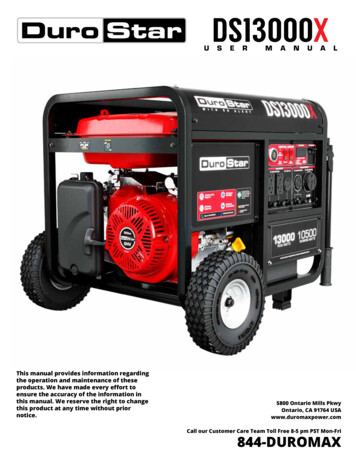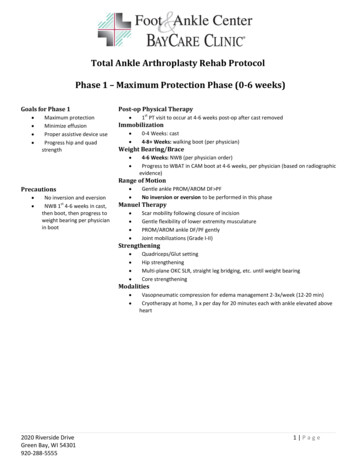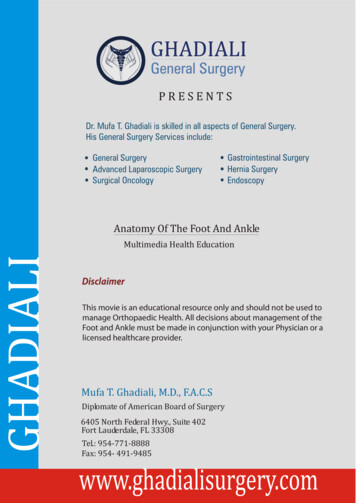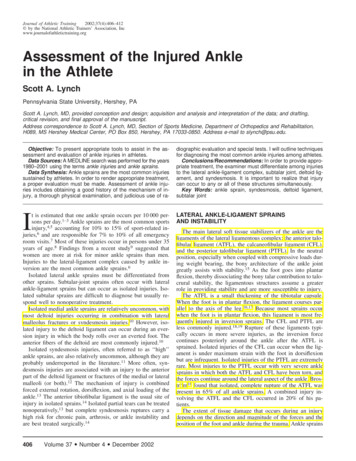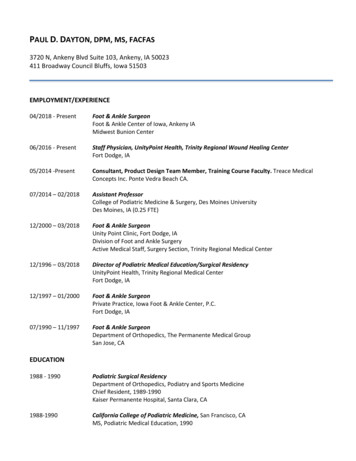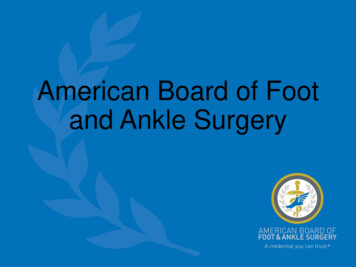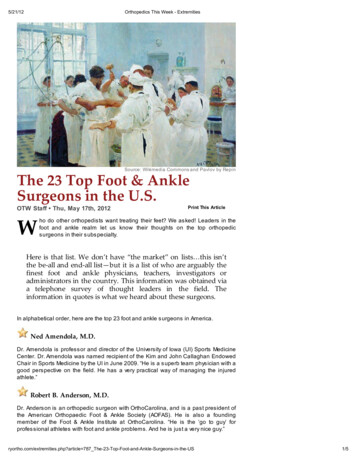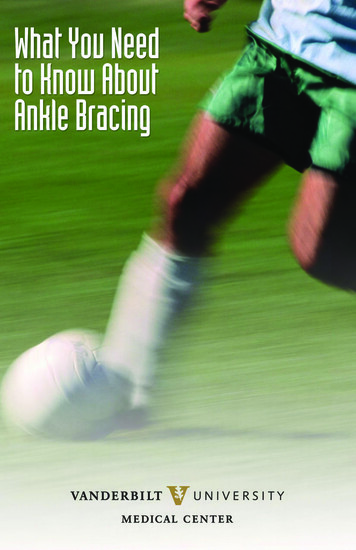
Transcription
Questions for physician or Rehabilitation TeamTable of ContentsWhy Brace? . . . . . . . . . . . . . . . . . . . . . . . . . . . . . 2Tape or Brace? . . . . . . . . . . . . . . . . . . . . . . . . . . 3Types of Ankle Braces . . . . . . . . . . . . . . . . . . . 4Ankle Bracing Tips . . . . . . . . . . . . . . . . . . . . . . 7ReferencesAmoroso PJ, Ryan J, Bickley B, Leitschuh P, Taylor D, JonesB. Braced for impact: reducing military paratroopers’ anklesprains using outside-the-boot braces. The Journal of Trauma.1998;45:575-580.2.Garrick JG, Requa RK. Role of external support in the prevention ofankle sprains. Medicine and Science in Sports. 1973;5:200-203.1020Sitler M, Ryan J, Wheeler B, McBride J, Arciero R, Anderson J,Horodyski MB. The efficacy of a semirigid ankle stabilizer toreduce acute ankle injuries in basketball. The American Journal ofSports Medicine. 1994;22:454-461.ight3.yrAntioch High SchoolEast Literature Magnet SchoolFranklin Road AcademyGlencliff High SchoolHarpeth High School in Kingston SpringsHillwood High SchoolHume Fogg High SchoolHunters Lane High SchoolMaplewood High SchoolMartin Luther King Jr. High SchoolMcGavock High SchoolOverton High SchoolPearl-Cohn High SchoolStratford High SchoolUniversity School of NashvilleWhites Creek High SchoolCop 1.-VVanderbilt Orthopaedic Institute, Vanderbilt University, BelmontUniversity, local high schools (listed below), and Vanderbilt SportsMedicine Clinics in Franklin and Martin, Tennessee.andVanderbilt Sports Medicine Certified AthleticTrainers provide coverage for:erbiltSportsMedicine4.Surve I, Schwellnus MP, Noakes T, Lombard C. A fivefold reductionin the incidence of recurrent ankle sprains in soccer playersusing the sport-stirrup orthosis. The American Journal of SportsMedicine. 1994;22:601-606.5.Moiler K, Hall T, Robinson K. The role of fibular tape in theprevention of ankle injury in basketball: a pilot study. Journal ofOrthopaedic & Sports Physical Therapy. 2006;36:661-668.Please visit our web site at www.vanderbiltorthopaedics.com81
Why Brace?Ankle injuries, specificallysprains, are one of the mostcommon injuries experiencedby physically active people.Approximately 25,000 peoplesprain their ankles on adaily basis according to theAmerican Orthopaedic Footand Ankle Society. Most ankleinjuries happen as a result ofrolling the ankle to the side andover stretching the ligamentsor tendons that surround theankle joint.Ankle Bracing TipsADVANTAGES OF BRACING: Stability Balance Improved functional movement Decreased painltSportsMedicine Support10-VanderbiAnkle sprains are categorized by degree of severity. A first degree(mild) sprain is the stretching or minor tearing of ligaments causingthe ankle to loosen. A second degree (moderate) sprain is the tearingof ligaments resulting in increased ankle loosening. A third degree(severe) ankle sprain is the complete tear of ligaments causing the ankleto be very loose and unstable. Once the support structures have beendamaged, they become inefficient in providing support during athleticactivities and activities of daily living. Therefore, your physician maysuggest you use an ankle brace to aid the ankle’s structural stability,balance, and functional movement patterns until these deficits can becorrected through rehabilitation therapy or surgical intervention. Check brace fit – snug and comfortable Straps and/or laces should be tightened to comfortabletension Tight, comfortable straps and laces make supportivebraces Walk around and recheck brace fit prior to activity Adjust brace fit during activity to ensure support If your brace is not comfortable or you are experiencingproblems contact your physical therapist or certified athletictrainer.Copyright20The most current evidence reveals that the use of ankle bracingor athletic tape applied by a certified athletic trainer has decreasedthe incidence of initial ankle injuries and re-injuries, as well asreducing the severity of ankle injuries that did occur.1-5 Bracingor taping protects the ankle by restraining lateral motion andproprioceptive feedback. Studies have shown favorable resultsfor both bracing and taping. However, the disadvantage of tapingis that it needs to be applied by a certified athletic trainer and itwill stretch during activity and lose some of its rigid support.5 Theproperly fitted ankle brace will maintain its rigidity much longerand can be re-adjusted during activity to ensure its effectiveness.This brochure will review four categories of functional ankle bracesyour evaluating physician, physical therapist, or certified athletictrainer (ATC) may recommend: athletic tape, compression braces,semi-rigid braces and rigid braces.WEARING YOUR BRACE:2CARING FOR YOUR BRACE: Check regularly for holes, cracks and excessive wear-andtear, replace any broken or damaged pieces Hand wash Neoprene, liners, pads and straps in cold waterand mild detergent and air dry Braces can be used in fresh and salt water but must berinsed with fresh, clean water and air dried7
Types of Ankle Braces - cont.ineedicMbiThe rigid brace provides more side toRigid Braceside support than the semi-rigid braces,yet may be difficult to fit in some shoes.After the ankle heals, a more functional lace-up ankle brace isrecommended to prevent further injury.Currently, many physicians, physical therapists,andcertifiedathletictrainers suggest the useof athletic tape or bracingfor the prevention of ankleinjuries and the protectionof previous injuries. Anexternal ankle support helpsto decrease the incidenceof repeat (chronic) anklesprains by aiding balanceand structural stability during activity. Additionally, an anklebrace will improve muscle reaction time and provide an improvedsense of what your ankle is doing while in motion (proprioception),decreasing the risk of injury.rtsThe rigid stirrup ankle support isperhaps the most widely used brace insports today due to the effectiveness andversatility in treating ankle sprains, stressfractures, and (chronic) repeat anklesprains. It is made of a hard plastic shellthat extends up both sides of the ankleand is strapped into place with easilyadjustable Velcro straps.ltSpoRigid Brace:Tape or Brace?erSeveral factors impact the efficacy of taping and bracing:The benefits of rigid braces include:and The materials that compose the brace or taping technique Increased side to side support compared to the semi-rigidbrace The application of the brace or tape-V The design of the brace. Provides compression which reduces swelling associatedight2010The optimal effectiveness of athletic tape is only realized whenapplied by a certified athletic trainer using the proper techniqueand materials for the injury. The tape will loosen as activityduration increases. Ankle braces loosen similar to tape; however,braces may be adjusted to improve stability, whereas, tape cannotbe adjusted and must be reapplied.CopyrA common misunderstanding is that the ankle brace willslow or decrease performance, yet there is minimal to no effecton activity. A properly applied ankle brace will allow for bestperformance with the protection necessary for return to activityfollowing an ankle injury or to prevent reinjury.63
Types of Ankle Braces - cont.Types of Ankle BracesCompression Brace:The benefits of compression braces include:rtsMedicineNeoprene or elastic compression braces are used in aiding thetreatment of mild ankle sprains andtendinitis. Elastic braces consist of alight weight stretchable material andprovide the ankle joint with compressivesupport. Compression enhances jointsupport and balance, while still allowingthe motion necessary for daily functionsand sport activities.CompressionltSpo Maintains ankle joint warmth, decreasing muscle stiffnessand associated discomfort during activityThe benefits of lace-up braces include: Combines durability with a comfortable, lightweight feel Provides more support than the compression brace and fitsin most shoes Universal fit for either the right or the left anklebi Provides compression which reduces swelling associatedwith injuryjoint size or shoe size. Brace fitting and adjustment is provided bysome type of lace-up / Velcro system. The braces may have an optionto insert semi-rigid supports for added lateral and medial stability.The braces with external straps provide a figure-8 strapping systemthat allows for rapid tightening without re-lacing the entire brace.The benefit of the straps is increased ankle support. These bracesare reusable, but require more time to put on and take off than thesemi-rigid hinged brace, especially those with the figure-8 strappingsystem.er Fitted easily by measuring ankle joint size or shoe sizeand Universal fit for either the right or the left ankleThe hinged ankle brace is anothertype of semi-rigid brace. These bracesare designed to prevent rolling the anklefrom side to side without affecting theup and down motion of the ankle. Theywill feature padded sides for increasedcomfort and either one or two Velcrostraps for quick adjustment and easy onand off application.-VSemi-Rigid Brace:10Lace-Upight20The lace-up ankle brace is one ofthe most common types of semi-rigidankle braces. These braces are used formild to moderate ankle sprains or forthe prevention of repeat ankle sprainsthat occur with activity. The lace-upbraces are designed to limit the anklefrom rolling side to side as well as theup and down ankle motion, theoreticallyproviding “full ankle support”.HingedCopyrHingedSemi Rigid Lace upThe benefits of hinged ankle braces include: Increased side to side support compared to the lace-upbrace Designed to fit in most shoesThese braces are available in a variety of types, includingthose with and without figure-8 strapping systems. Similar to thecompression braces, the lace-up brace will fit according to ankle4 Constructed to fit contour of the right or the left ankle5
Types of Ankle Braces - cont.Types of Ankle BracesThe benefits of compression braces include:edicinejoint size or shoe size. Brace fitting and adjustment is provided bysome type of lace-up / Velcro system. The braces may have an optionto insert semi-rigid supports for added lateral and medial stability.The braces with external straps provide a figure-8 strapping systemthat allows for rapid tightening without re-lacing the entire brace.The benefit of the straps is increased ankle support. These bracesare reusable, but require more time to put on and take off than thesemi-rigid hinged brace, especially those with the figure-8 strappingsystem.The benefits of lace-up braces include: Combines durability with a comfortable, lightweight feelltSpo Maintains ankle joint warmth, decreasing muscle stiffnessand associated discomfort during activity Provides more support than the compression brace and fitsin most shoes Provides compression which reduces swelling associatedwith injurybi Universal fit for either the right or the left ankleer Fitted easily by measuring ankle joint size or shoe sizeHingedand Universal fit for either the right or the left ankleMNeoprene or elastic compression braces are used in aiding thetreatment of mild ankle sprains andtendinitis. Elastic braces consist of alight weight stretchable material andprovide the ankle joint with compressivesupport. Compression enhances jointsupport and balance, while still allowingthe motion necessary for daily functionsand sport activities.CompressionrtsCompression Brace:The hinged ankle brace is anothertype of semi-rigid brace. These bracesare designed to prevent rolling the anklefrom side to side without affecting theup and down motion of the ankle. Theywill feature padded sides for increasedcomfort and either one or two Velcrostraps for quick adjustment and easy onand off application.-VSemi-Rigid Brace:20htigHingedyrSemi Rigid Lace upCopThe lace-up ankle brace is one ofthe most common types of semi-rigidankle braces. These braces are used formild to moderate ankle sprains or forthe prevention of repeat ankle sprainsthat occur with activity. The lace-upbraces are designed to limit the anklefrom rolling side to side as well as theup and down ankle motion, theoreticallyproviding “full ankle support”.10Lace-UpThe benefits of hinged ankle braces include: Increased side to side support compared to the lace-upbrace Designed to fit in most shoesThese braces are available in a variety of types, includingthose with and without figure-8 strapping systems. Similar to thecompression braces, the lace-up brace will fit according to ankle4 Constructed to fit contour of the right or the left ankle5
Types of Ankle Braces - cont.Tape or Brace?Rigid Brace:rtsMedicineThe rigid stirrup ankle support isperhaps the most widely used brace insports today due to the effectiveness andversatility in treating ankle sprains, stressfractures, and (chronic) repeat anklesprains. It is made of a hard plastic shellthat extends up both sides of the ankleand is strapped into place with easilyadjustable Velcro straps.erbiltSpoThe rigid brace provides more side toRigid Braceside support than the semi-rigid braces,yet may be difficult to fit in some shoes.After the ankle heals, a more functional lace-up ankle brace isrecommended to prevent further injury.andThe benefits of rigid braces include:-V Increased side to side support compared to the semi-rigidbraceCopyright2010 Provides compression which reduces swelling associated6Currently, many physicians, physical therapists,andcertifiedathletictrainers suggest the useof athletic tape or bracingfor the prevention of ankleinjuries and the protectionof previous injuries. Anexternal ankle support helpsto decrease the incidenceof repeat (chronic) anklesprains by aiding balanceand structural stability during activity. Additionally, an anklebrace will improve muscle reaction time and provide an improvedsense of what your ankle is doing while in motion (proprioception),decreasing the risk of injury.Several factors impact the efficacy of taping and bracing: The materials that compose the brace or taping technique The application of the brace or tape The design of the brace.The optimal effectiveness of athletic tape is only realized whenapplied by a certified athletic trainer using the proper techniqueand materials for the injury. The tape will loosen as activityduration increases. Ankle braces loosen similar to tape; however,braces may be adjusted to improve stability, whereas, tape cannotbe adjusted and must be reapplied.A common misunderstanding is that the ankle brace willslow or decrease performance, yet there is minimal to no effecton activity. A properly applied ankle brace will allow for bestperformance with the protection necessary for return to activityfollowing an ankle injury or to prevent reinjury.3
Why Brace?Ankle Bracing TipsAnkle injuries, specificallysprains, are one of the mostcommon injuries experiencedby physically active people.Approximately 25,000 peoplesprain their ankles on adaily basis according to theAmerican Orthopaedic Footand Ankle Society. Most ankleinjuries happen as a result ofrolling the ankle to the side andover stretching the ligamentsor tendons that surround theankle joint.ADVANTAGES OF BRACING: Supportine Stabilityedic Balance Improved functional movementltSpoWEARING YOUR BRACE:rtsM Decreased pain Check brace fit – snug and comfortableAnkle sprains are categorized by degree of severity. A first degree(mild) sprain is the stretching or minor tearing of ligaments causingthe ankle to loosen. A second degree (moderate) sprain is the tearingof ligaments resulting in increased ankle loosening. A third degree(severe) ankle sprain is the complete tear of ligaments causing the ankleto be very loose and unstable. Once the support structures have beendamaged, they become inefficient in providing support during athleticactivities and activities of daily living. Therefore, your physician maysuggest you use an ankle brace to aid the ankle’s structural stability,balance, and functional movement patterns until these deficits can becorrected through rehabilitation therapy or surgical intervention.2biander Tight, comfortable straps and laces make supportivebraces Walk around and recheck brace fit prior to activity-V Adjust brace fit during activity to ensure support2010 If your brace is not comfortable or you are experiencingproblems contact your physical therapist or certified athletictrainer.ightCARING FOR YOUR BRACE:yr Check regularly for holes, cracks and excessive wear-andtear, replace any broken or damaged piecesCopThe most current evidence reveals that the use of ankle bracingor athletic tape applied by a certified athletic trainer has decreasedthe incidence of initial ankle injuries and re-injuries, as well asreducing the severity of ankle injuries that did occur.1-5 Bracingor taping protects the ankle by restraining lateral motion andproprioceptive feedback. Studies have shown favorable resultsfor both bracing and taping. However, the disadvantage of tapingis that it needs to be applied by a certified athletic trainer and itwill stretch during activity and lose some of its rigid support.5 Theproperly fitted ankle brace will maintain its rigidity much longerand can be re-adjusted during activity to ensure its effectiveness.This brochure will review four categories of functional ankle bracesyour evaluating physician, physical therapist, or certified athletictrainer (ATC) may recommend: athletic tape, compression braces,semi-rigid braces and rigid braces. Straps and/or laces should be tightened to comfortabletension Hand wash Neoprene, liners, pads and straps in cold waterand mild detergent and air dry Braces can be used in fresh and salt water but must berinsed with fresh, clean water and air dried7
ineedicMrtsltSpobierand-V1020htigyrCopFor more information on this and other injuries see our website:www.vanderbiltorthopaedics.comThis information is intended for education of the reader about medical conditions and currenttreatments. It is not a substitute for examination, diagnosis, and care provided by yourphysician or a licensed healthcare provider. If you believe that you, your child, or someone youknow has the condition described herein, please see your healthcare provider. Do not attemptto treat yourself or anyone else without proper medical attention. All rights reserved 2009,Vanderbilt University, Vanderbilt University Medical Center, Vanderbilt Children’s Hospital.
Provides more support than the compression brace and fits in most shoes Universal fit for either the right or the left ankle Hinged The hinged ankle brace is another type of semi-rigid brace. These braces are designed to prevent rolling the ankle from side to side without affecting the up and down motion of the ankle. They

